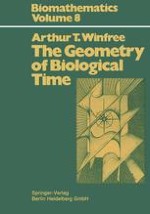1980 | OriginalPaper | Buchkapitel
Circadian Rhythms in General
verfasst von : Arthur T. Winfree
Erschienen in: The Geometry of Biological Time
Verlag: Springer Berlin Heidelberg
Enthalten in: Professional Book Archive
Aktivieren Sie unsere intelligente Suche, um passende Fachinhalte oder Patente zu finden.
Wählen Sie Textabschnitte aus um mit Künstlicher Intelligenz passenden Patente zu finden. powered by
Markieren Sie Textabschnitte, um KI-gestützt weitere passende Inhalte zu finden. powered by
One doesn’t have to look at many living organisms before noticing that a lot of behavioral physiology is temporally organized in periodic patterns. In fact, if I had to decide what impresses me as the single most conspicuous feature of natural ecosystems, I would say that it is the daily and seasonal periodism and the consequent temporal organization of niche structure, food webs, and behavior. Of course, it would seem natural to assume that any given daily rhythm or seasonal rhythm is a response to the environmental cycle of days and nights, summer and winter. This is often the case. It is, for example, in the case of “deep scattering layers”. These are layers of diverse fauna in all the world’s oceans that show up very clearly on sonar. They go deeper in the daytime and rise back toward the surface by night. My job on an Indian Ocean Expedition cruise from Woods Hole in summer of 1964 was to study these deep scattering layers using sonar and tow nets during their diurnal up-and-down migrations. Investigators in Cousteau’s diving saucer found that the deep scattering layer consists largely of small fish. They seem to simply follow light intensity, e.g., they come up during eclipses. Enright and Hamner (1967) later found a substantial role of endogenous rhythmicity in the vertical diurnal migrations of invertebrates in the scattering layers.
